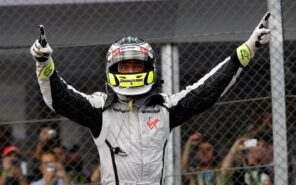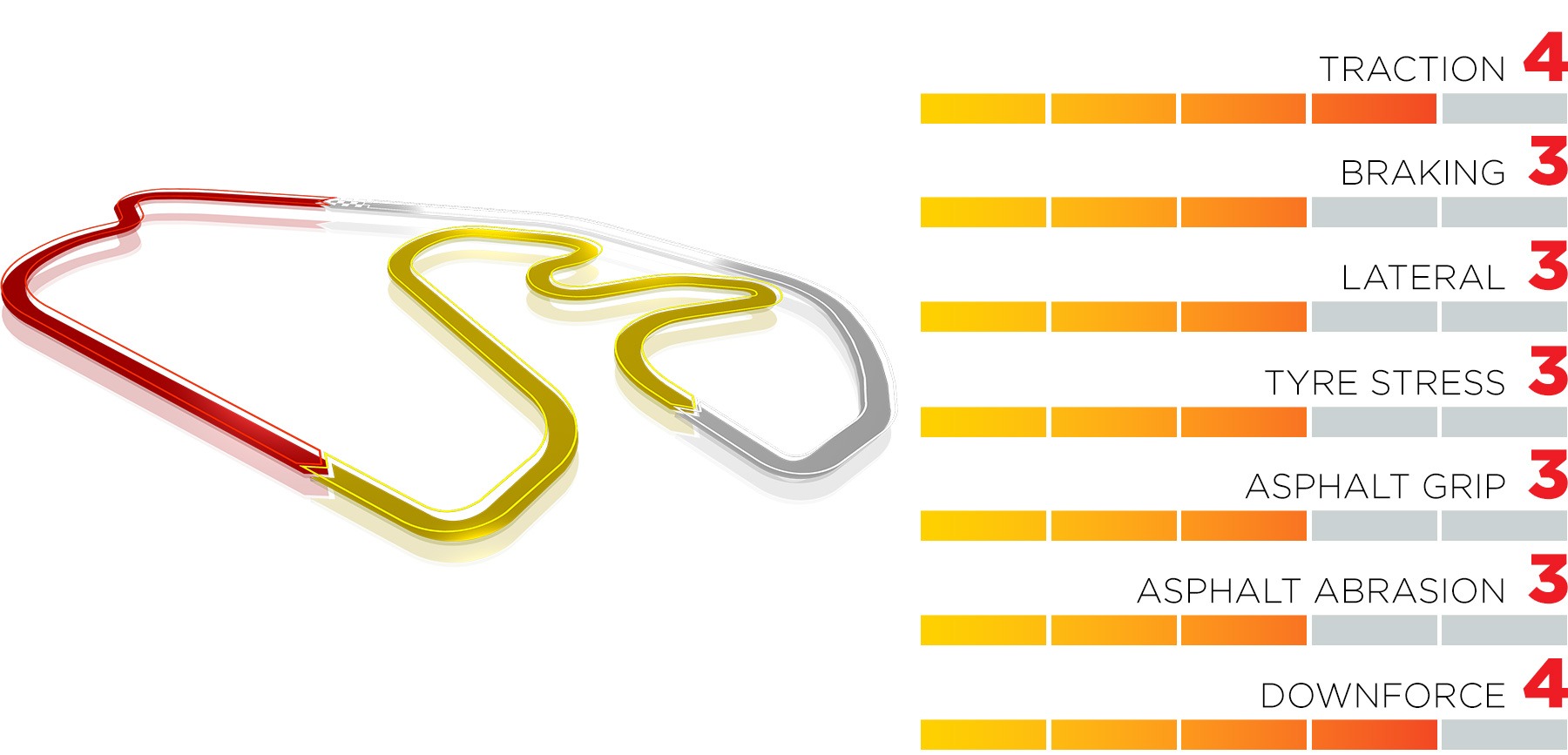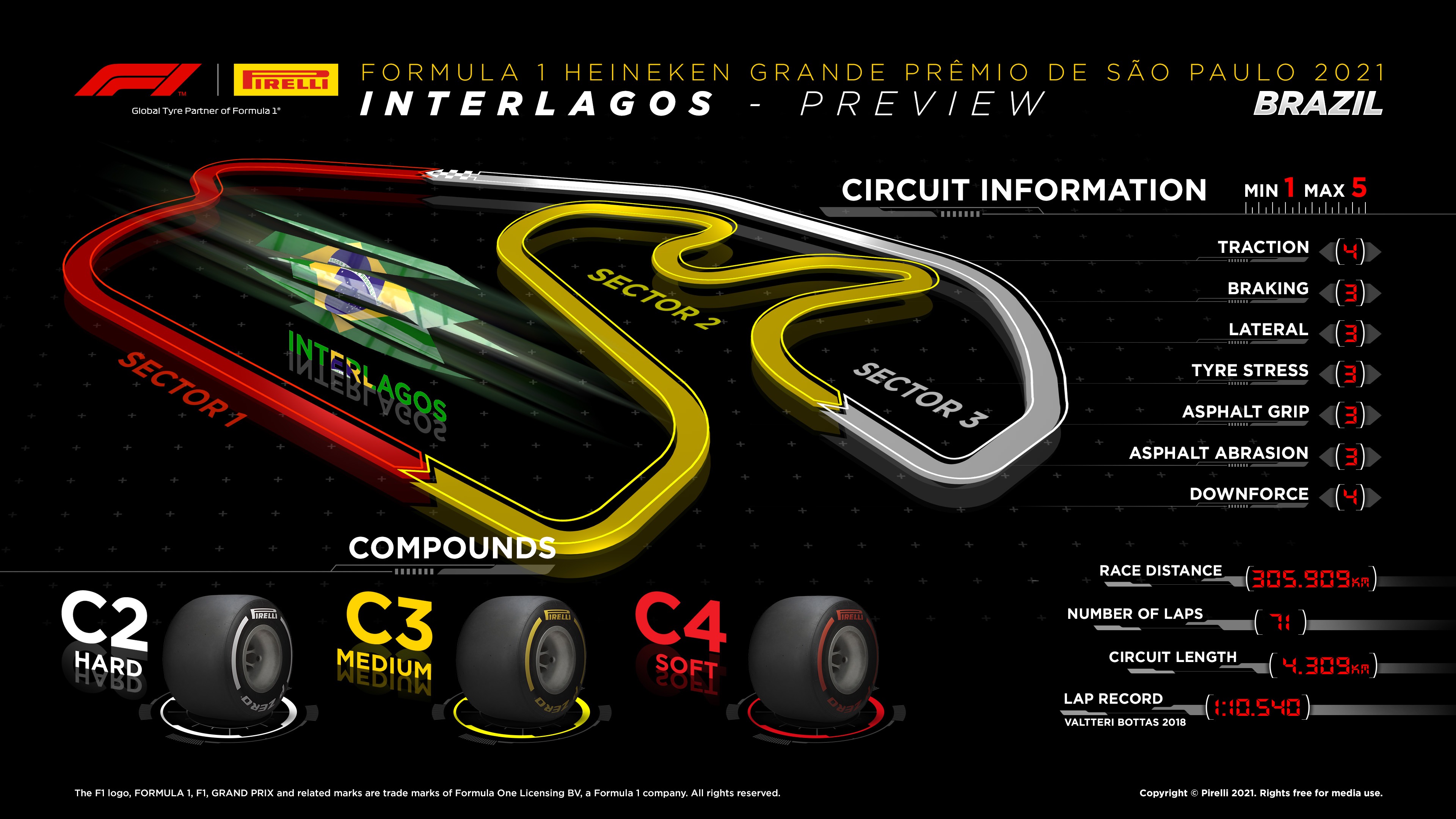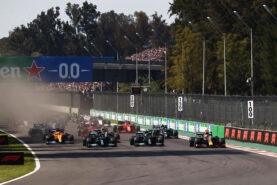All info you want to see before the 2021 Brazilian F1 GP starts
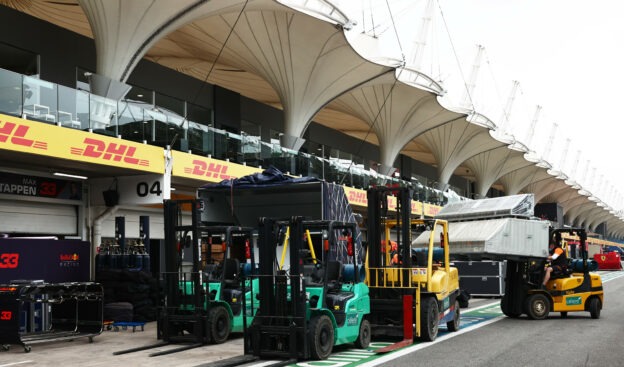
Brazil returns to the Formula 1 calendar two years after providing racing fans with one of the most entertaining races in recent memory in 2019. The country returns with the 2021 Sao Paulo Grand Prix, yet another race named after the host city. We’re all looking forward to having a good race at Brazil, and see if Red Bull’s and Max Verstappen’s fortunes in the World Drivers’ Championship continue to be favorable and if they can hit Mercedes with another devastating blow.
The 2021 Sao Paulo Grand Prix will be the 19th round of the 2021 Formula 1 World Championship and the third weekend with the sprint format, with a Sprint Qualifying on Saturday to determine Sunday’s grid. At this point in the year, things are looking increasingly good for Red Bull Racing and Max Verstappen in both the World Constructors’ and Drivers’ Championships.
With consecutive wins at Austin and México, Verstappen has a 19-point gap over Lewis Hamilton and his Mercedes. Moreover, after three consecutive double podiums, Red Bull is now only one point behind Mercedes in the World Constructors’ Championship, showing how the team is taking advantage of the great machinery it possesses in 2021.
Brazil has been a strong circuit for Red Bull recently, with Verstappen winning in 2019 and leading in 2018 before getting into a scuffle with Esteban Ocon, who was a backmarker. With Honda, Verstappen won from Pole Position in 2019 and the Japanese engine manufacturer also put Pierre Gasly’s then Toro Rosso in the podium.
Mercedes desperately needs to have a strong weekend, but the Autódromo José Carlos Pace might not be the best to do so as things currently look. Hamilton has a couple of wins in Brazil under his belt, but Mercedes has not been dominant at the track since F1 moved to the new, wider cars in 2017.
Hamilton has finished second in the last two races, maximizing what Mercedes had during those weekends, but that will not be enough in a WDC fight that is starting to look clearly in Red Bull’s favor, both on the track and in the standings.
Best of the rest F1 team and midfield battles
The Scuderia Ferrari (Charles Leclerc and Carlos Sainz) is now sitting in third place in the 2021 World Constructors’ Championship after taking fifth and sixth in the Mexico City Grand Prix and surpassing McLaren (Lando Norris and Daniel Ricciardo). The Italian team surpassed the Woking-based outfit and is now ahead by 13.5 points, which is not a small amount given how many points are available for these two teams under normal circumstances.
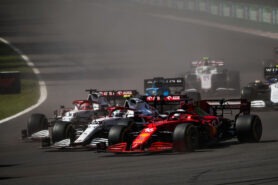
Start of the 2021 Mexico race: LECLERC Charles (mco), Scuderia Ferrari SF21, GIOVINAZZI Antonio (ita), Alfa Romeo Racing ORLEN C41, RAIKKONEN Kimi (fin), Alfa Romeo Racing ORLEN C41 (Photo Florent Gooden / DPPI)
The Ferrari drivers have each taken three consecutive finishes in the points, including three Top 5s, while McLaren has scored with both cars only once in the last three races and scored just one point in México.
Alpine (with Fernando Alonso and Esteban Ocon) remains in P5 in the WCC, but after scoring just three points in the last three rounds, AlphaTauri (Pierre Gasly and Yuki Tsunoda) has now tied the French team on points after Gasly’s brilliant P4 at México. Due to Esteban Ocon’s win in the 2021 Hungarian Grand Prix, Alpine remains ahead of AT, even though both teams have 106 points.
Aston Martin (Sebastian Vettel and Lance Stroll) has scored points in three consecutive events, albeit with just one car, but remains seventh in the WCC without any risks or many achievements ahead (AM has 68 points).
Williams (George Russell and Nicholas Latifi) has been deflated as of late and has now three straight races without getting near the Top 10. Still, the team remains eighth with 23 points, its best tally since 2017.
Alfa Romeo (Kimi Raikkonen and Antonio Giovinazzi) has scored points in two of the last four races after Raikkonen’s P8 at México and sits ninth with 11 points. Haas (Mick Schumacher and Nikita Mazepin) close out the Constructors’ standings without points.
2021 Sao Paulo GP Facts & Figures
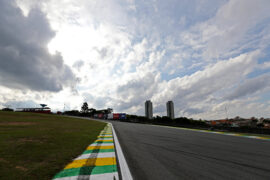
A general view of the circuit during previews ahead of the F1 Grand Prix of Brazil at Autodromo Jose Carlos Pace on November 14, 2019 (Photo by Robert Cianflone/Getty Images)
The 2021 edition will be the first of the Sao Paulo Grand Prix and the 48th Formula 1 World Championship race held in Brazil.
The first Formula 1 race at Brazil was won by Carlos Reutemann in 1972 for Brabham, but the event was not part of the World Championship.
The first Brazilian GP that was part of the Formula 1 World Championship calendar came in 1973, at Interlagos. Emerson Fittipaldi took two famous wins at home in 1973 and 1974, with Lotus and McLaren, respectively.
The GP was again won by a Brazilian in its third edition, with José Carlos Pace winning for Brabham at the track that is now named after him. Niki Lauda won in 1976 for Ferrari, while Reutemann won again at Brazil in 1977 and 1978, with the 1978 race being celebrated at Rio de Janeiro’s Jacarepaguá Circuit, and giving three straight wins at the country to Ferrari.
The event returned to the criticized, bumpy Interlagos for 1979 and 1980, with Jacques Laffite and Rene Arnoux winning.
The Brazilian Grand Prix moved from Sao Paulo to Rio for the events held between 1981 and 1989 due to safety concerns regarding the Interlagos asphalt, and the overall facilities. At Rio, Nelson Piquet’s home, the event was very popular, and it produced some controversial situations early.
Reutemann won in 1981 ahead of his teammate and reigning champion Alan Jones after ignoring team orders to let the Australian by. Then, Piquet won at home in 1982, but the Brazilian driver and second-placed finisher Keke Rosberg were disqualified due to the water-cooled brakes of their Brabham and Williams cars, respectively.
The disqualification came during a heated point of the war between the Federation Internationale du Sport Automobile (FISA) and the Formula One Constructors Association (FOCA). FISA was a subcommittee of the FIA that was the governing body of F1 and motor racing.
The events of the 1982 Brazilian GP led to the boycott of the FOCA teams of the 1982 San Marino Grand Prix, won by Ferrari driver Didier Pironi ahead of Gilles Villeneuve, which started another war that ended with unfortunate situations.
Prost was named as the 1982 winner for Renault, and he won again in 1984, 1985, 1987 and 1988 at Jacarepaguá with McLaren. Nelson Piquet won with Brabham BT52 at home in 1983 en route to his second F1 World Championship, and he repeated the GP success in 1986 for Honda.
The 1988 Brazilian Grand Prix was Ayrton Senna’s first race and first Pole Position for McLaren, but he was disqualified from the race due to a pre-race procedure in which he jumped into the spare car to start from the pits after the green flag was shown.
Nigel Mansell won for Ferrari, in his debut race with the team in 1989, in what was the first victory of a car with a semi-automatic gearbox. The 1989 event was the final F1 race at Jacarepaguá before the circus returned to an updated, shortened Interlagos.
Prost won again at Brazil in the return to Sao Paulo in 1990, while Ayrton Senna took arguably his most emotional win in 1991. It was his first at home and Senna won that race after struggling with the gearbox in his car and holding Williams’ Riccardo Patrese off.
Senna repeated in a wet 1993 Brazilian Grand Prix, a year after Nigel Mansell dominated in 1992 at the wheel of the FW14B. Senna had a big fight with Michael Schumacher in 1994, but he spun in the late stages and the German won the race in what has been mentioned as the final battle between the two all-time greats, as Senna passed away two races later after an unfortunate crash.
Schumacher won again for Benetton in 1995, albeit after being excluded due to a fuel infraction and being reinstated later. Williams won in 1996 and 1997 with eventual champions Damon Hill and Jacques Villeneuve.
The Drivers’ Champion has won at Brazil since 1994, and Mika Hakkinen continued the streak in 1998 and 1999, while Schumacher repeated the feat in 2000.
David Coulthard won for McLaren in 2001, after a big overtake by Juan Pablo Montoya on Schumacher into Turn 1 and then crashing out of the race after backmarker Jos Verstappen took him out of the lead.
Michael Schumacher won in 2002, while Giancarlo Fisichella won a crazy, rain-affected 2003 event. Montoya then won in his final race for Williams in 2004, as the event was moved towards the end, or the actual end of the calendar.
From 2005 to 2009, the World Drivers’ Championship was decided at Brazil, whether the race was the final of the year or not. Fernando Alonso sealed his two titles in 2005 and 2006, with the 2006 event being the last of the year, and being Michael Schumacher’s final race with Ferrari.
Kimi Raikkonen won Ferrari’s most recent WDC after winning the 2007 race, beating McLaren-Mercedes’ Lewis Hamilton and Fernando Alonso.
Hamilton won his first title in one of the most epic title-deciding races ever seen in F1 history. Felipe Massa won the race for Ferrari, and with Hamilton out of the needed places to win the title, the Brazilian was set to become a World Champion at his home GP. However, Hamilton, on wet-weather tyres, surpassed Timo Glock’s Toyota (equipped with dry tyres) into the last corner of the final lap of the final Grand Prix of the season.
Ultimately, Hamilton’s fifth place gave him a one-point edge over Massa and won McLaren’s most recent World Drivers’ title.
Jenson Button sealed his 2009 World Championship for Brawn GP at Brazil, with one race to spare.
The eventual champion won again at Brazil in 2010, with Sebastian Vettel winning for Red Bull. Mark Webber won in 2011 after Vettel’s car ran into mechanical trouble (gearbox) and the German allowed him through.
The 2012 Brazilian Grand Prix was another showdown for the World Drivers’ Championship. Sebastian Vettel entered the race with the lead over Fernando Alonso’s Ferrari, but the German’s race was dramatic, with an early crash almost ending his race, but he then recovered in tough weather conditions to finish in the needed places to beat the Spaniard, to did what he needed (finish in the podium) to have a chance.
Both were fighting to become a three-time World Champion, and it was Vettel who eventually did it for Red Bull, achieving his third consecutive title. Vettel won the 2013 Brazilian Grand Prix to end his dominant 2013 campaign with his nine consecutive win (an all-time record) and his record-equalling 13th win of the year (equalling Michael Schumacher’s tally from 2004).
Mercedes dominated the event at the start of the hybrid era, with Nico Rosberg leading a couple of 1-2s in 2014 and 2015, and Hamilton doing so in 2016 on an extremely wet race which saw a great recovery by Max Verstappen’s Red Bull near the end to finish third.
Vettel won for Ferrari in 2017, while Lewis Hamilton won for Mercedes in 2018 after Max Verstappen’s crash with Esteban Ocon while the Dutchman was leading the race and the backmarker was trying to unlap himself on fresher tyres.
The Dutchman came back strong to win a crazy 2019 Brazilian Grand Prix from Pole Position for Red Bull-Honda, ahead of Pierre Gasly and Carlos Sainz, and after a good battle with Lewis Hamilton in the race.
Among drivers, Alain Prost dominated at Brazil during his time, winning six races with Renault, McLaren and Ferrari Among teams, McLaren leads Ferrari 12 to 11 in terms of wins at Brazil.
Autódromo José Carlos Pace
The Autódromo José Carlos Pace in Sao Paulo, Brazil, has hosted the Brazilian Grand Prix 37 times, and one non-championship race. Jacarepaguá, in Rio de Janeiro, hosted the race 10 times.
Initially, the track was named Autódromo de Interlagos, due to it being located between two lakes, the Represa de Guarapiranga and Represa Billings. In 1985, the circuit was named Autódromo José Carlos Pace in 1985, in honor of the former Brazilian Grand Prix winner, who died in an airplane accident in 1977.
The original Interlagos was 7.960 km long and hosted the Brazilian Grand Prix from 1972 to 1978. The track then had some minor changes, with the circuit having a whopping 26 corners and the length varying from 7.960 km to 7.873 km.
As Formula 1 went to Rio from 1981 to 1989 and returned to Sao Paulo in 1990, the Autódromo José Carlos Pace was updated and shortened to 4.325 km and 15 corners. Since 1990, it has had some minor changes, and the current layout remains 15-corner long and is 4.309 km long.
The 2021 race will be run over a distance of 305.909 km and will have 71 laps.
The lap record at the Autódromo José Carlos Pace was established by Valtteri Bottas, driving for Mercedes in 2018, with a 1:10.540 min lap in the 2018 race. Lewis Hamilton established the outright Fastest Lap in Qualifying for the 2018 race, with a 1:07.281 min lap in the Mercedes W09.
2021 Sao Paulo Grand Prix - Tyres
The dry tyres for the 2021 Sao Paulo Grand Prix will be the C2 as P Zero White hard, C3 as P Zero Yellow Medium, and C4 as P Zero Red soft.
Pirelli explained their choice to go with the hardest option with a statement in a press release: “The Brazilian Grand Prix will use the C2 compound as the P Zero White hard, C3 as the P Zero Yellow medium, and C4 as the P Zero Red soft: the same tyre choice as has been made for all the races on the American continent this year. This is a step softer than the tyre choice nominated for the Brazilian Grand Prix at Interlagos when it was last run in 2019 (with C1, C2, and C3 selected).
With the hard tyre not being used extensively in 2019, this year’s choice should allow a more even use of all the compounds and potentially wider variations in strategy.
Brazil is the final race this year run to a sprint qualifying format, leading to a different tyre allocation than normal. Rather than having 13 sets of tyres for a weekend, there will be just 12 sets. These consist of two sets of P Zero White hard, four sets of P Zero Yellow medium, and six sets of P Zero Red soft. In addition, the teams will have up to six sets of Cinturato Green intermediates and three sets of Cinturato Blue full wets available in case of wet weather.
The short and intense Interlagos lap is one of the relatively few anti-clockwise layouts on the calendar, with a non-stop succession of corners that keeps the tyres working hard: particularly the front-right. The short lap means that traffic can be an issue and there’s also a high safety car probability, so any sprint qualifying or race strategy needs to bear that in mind.
Apart from the long uphill Arquibancada left-hander, all of the 15 corners are reasonably short, meaning that the lateral loads on the tyres are contained and the energy demands quite low: it’s more about traction and braking.
The weather in Brazil at this time of year can range from intense heat to torrential rain, with some grooves having been cut in the asphalt to help drainage in the event of heavy rain.
In 2019, when the last Brazilian GP was held, Red Bull’s Max Verstappen won the Brazilian Grand Prix with a three-stop strategy, following two safety cars at the end of the race. There were three different strategies in the top four, with McLaren’s Carlos Sainz (fourth at the flag) stopping just once from last on the grid. Without the safety cars, a two-stop strategy would have been the favoured tactic.”
The minimum starting pressures for the tyres will be 22.0 PSI (front) and 20.0 PSI (rear).
2021 Sao Paulo Grand Prix - Weather Forecast
Friday, Nov 12th - FP1 & FP2
Conditions: Mainly cloudy and cool
Max. temperature: 17°C
Chance of rain: 40%
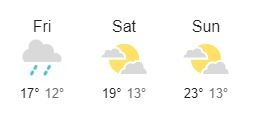 Saturday, Nov 13th - FP3 & Qualifying
Saturday, Nov 13th - FP3 & Qualifying
Conditions: A P.M shower in places
Max. temperature: 19°C
Chance of rain: 25%
Sunday, Nov 14th - Race
Conditions: Warmer with clouds and sun
Max. temperature: 23°C
Chance of rain: 3%
Who will be on the 2021 Sao Paulo Grand Prix podium?
The 2021 Formula 1 World Championship is entering its final stage, with only four races remaining and Max Verstappen and Red Bull getting closer and closer to dethroning Lewis Hamilton and Mercedes as champions.
The Dutchman has won two consecutive races and now enjoys a 19-point gap over the seven-time champion, and he is going to one of the tracks that have suited Red Bull quite well in the last few events.
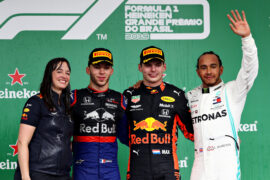
Top three finishers Max Verstappen, Pierre Gasly and Lewis Hamilton celebrate on the podium during the 2019 F1 Grand Prix of Brazil at Autodromo Jose Carlos Pace (Photo by Mark Thompson/Getty Images)
Verstappen will be looking for his second consecutive win at Brazil, while Hamilton and Mercedes need to take some points off the Dutch racer in order to go to the final three rounds with some hope that they can maintain their titles.
Sergio Pérez will definitely enter the weekend on a high after his unique podium at México, and Red Bull will certainly be difficult to beat for the British racer.
We’ll see what Valtteri Bottas is able to do for himself in the Sao Paulo Grand Prix, while Ferrari and McLaren will have an important chapter in their battle for P3 in the WCC that could be decisive, especially if Ferrari manages to stay clear of the Woking team and increase their gap to a seemingly impossible distance to cut for McLaren.
Pierre Gasly is coming off a podium at Brazil in 2019 and a solid P4 last week at México City, which would give him lots of confidence heading into Sao Paulo. The race is expected to be a dry one as of now, but Friday and Saturday could be tricky if the weather isn’t as straightforward as it has been in the other two editions of the Sprint Format in 2021.
The prediction for the Top 3 of the 2021 Sao Paulo Grand Prix is 1. Max Verstappen, 2. Sergio Pérez, 3. Lewis Hamilton.
✅ Check out more posts with related topics:



